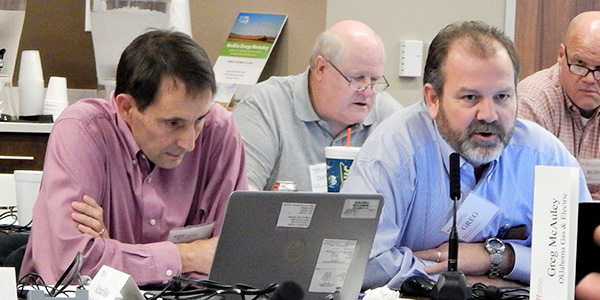By Tom Kleckner
LITTLE ROCK, Ark. — SPP members last week approved one of two Generator Interconnection Improvement Task Force recommendations but took no action on the second and agreed to disband the group.
The task force was formed last year to identify improvements in the RTO’s transmission study process, which is backlogged with more than 62 GW of interconnection requests. Its work will be carried on by various working groups.
The Market and Operations Policy Committee approved the GIITF’s suggestion to address generator interconnection studies in regions where the amounts of new generation being requested exceed load during spring and other light load periods.
SPP currently divides its footprint into cluster groups for individual study. In the high variable energy resource case, all VERs inside the cluster are set to 100% of capacity while external VERs are set to 20% to simulate counterflow to the internal generation.
With the increase in VERs, the amount of counterflow contained in the Integrated Transmission Planning models is high enough that the simulation is no longer needed, and the 20% setting has resulted in situations with insufficient load to absorb all the generation being requested. Under the new rules, the external VERs remain at the base reliability dispatch setting used in the ITP process.
“The changes here allow the energy to flow a further distance to a neighboring zone, which should identify [needed] transmission upgrades,” said Tradewind Energy’s Derek Sunderman.
Task force Chair Al Tamimi, of Sunflower Electric Power, said the change “might help us move forward with [definitive system impact studies].” Staff is working on study requests that date back to 2015.
“That should tell us something,” Oklahoma Gas & Electric’s Greg McAuley said. “We’re dancing around the problem. We have too much generation coming in, and we have no place to put it.”
McAuley pointed out that the Holistic Integrated Tariff Team is also working on the problem. “We don’t know where they’re going to land,” he said.
The measure passed with six opposing votes, mostly from transmission owners, and 14 abstentions.
Members declined to take a vote on the GIITF’s recommendation to change the criteria for allocating network upgrade costs to interconnection customers by adding a new energy resource interconnection service (ERIS) criterion.
Under the proposal, SPP would have first allocated cost responsibility to requests with 20% or more of the generator’s output flowing across a constrained element, as under current practice.
After applying the 20% transfer distribution factor (TDF) test, the proposal would have added a second screening to determine which requests have at least a 5% TDF. If the number of such requests resulted in a cumulative TDF of 20% or more, a mitigation would be assigned to the cluster, with the cost allocated to those requests with at least a 5% TDF.
SPP said the change would have resulted in the identification of four additional constraints in the DISIS-2016-001 study.
But several members said the recommendation didn’t go far enough in identifying constraints caused by interconnection requests. Staff agreed the current process doesn’t catch enough constraints.
The committee also accepted a storage white paper for incorporation into SPP’s generator interconnection processes. The document describes proposed rules for processing and evaluating storage interconnection requests. Two members opposed the motion and three abstained.





